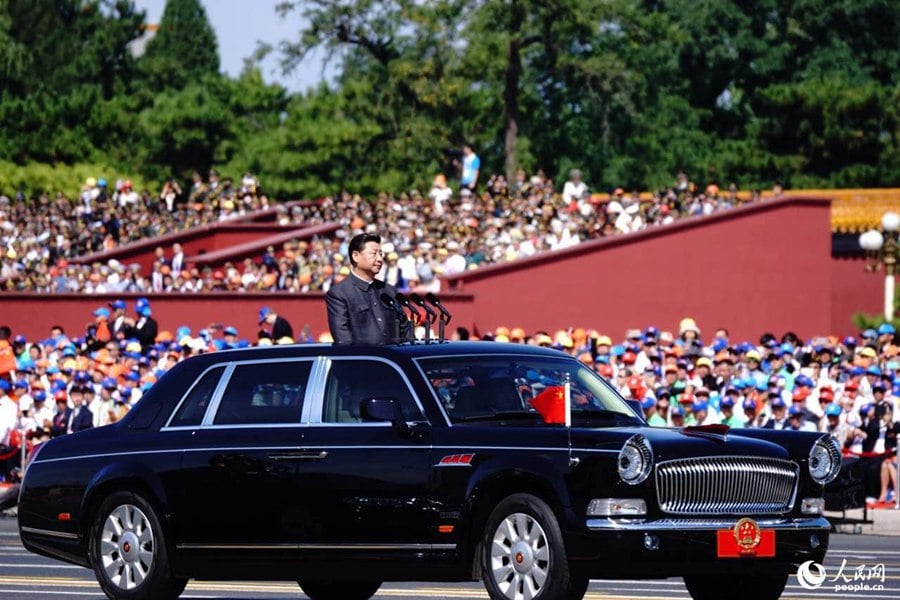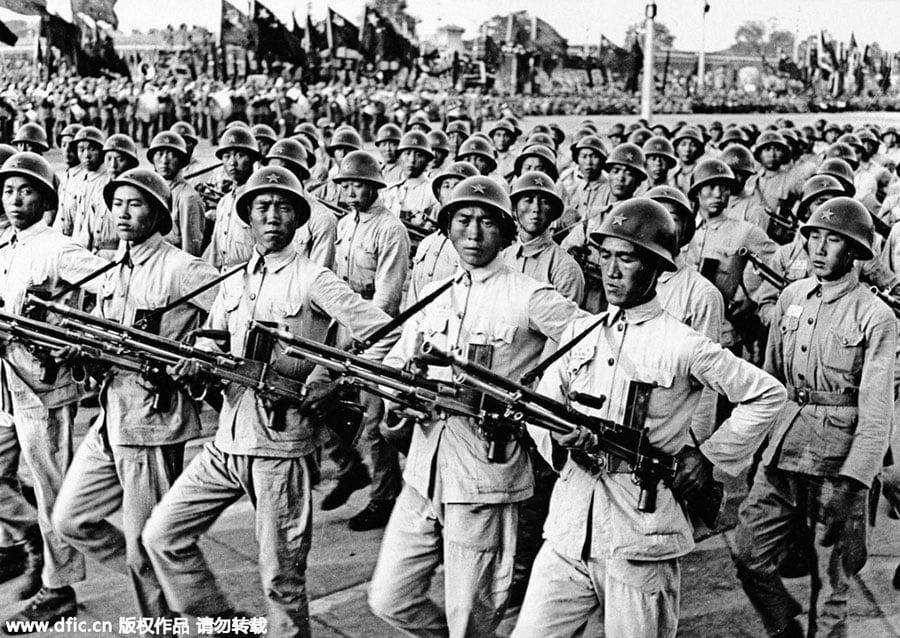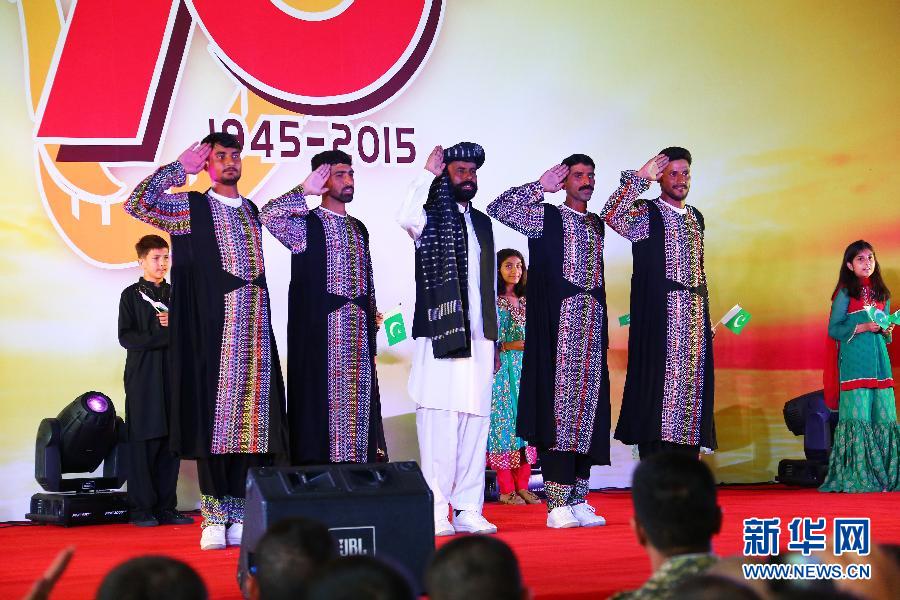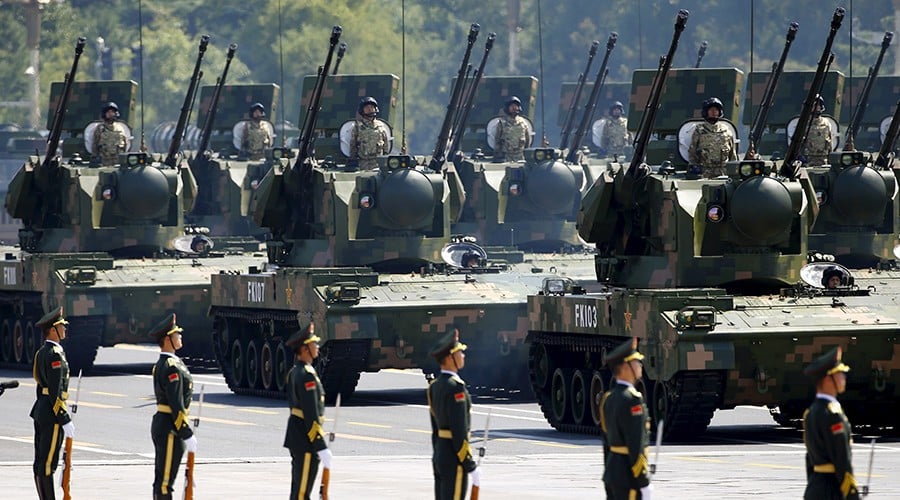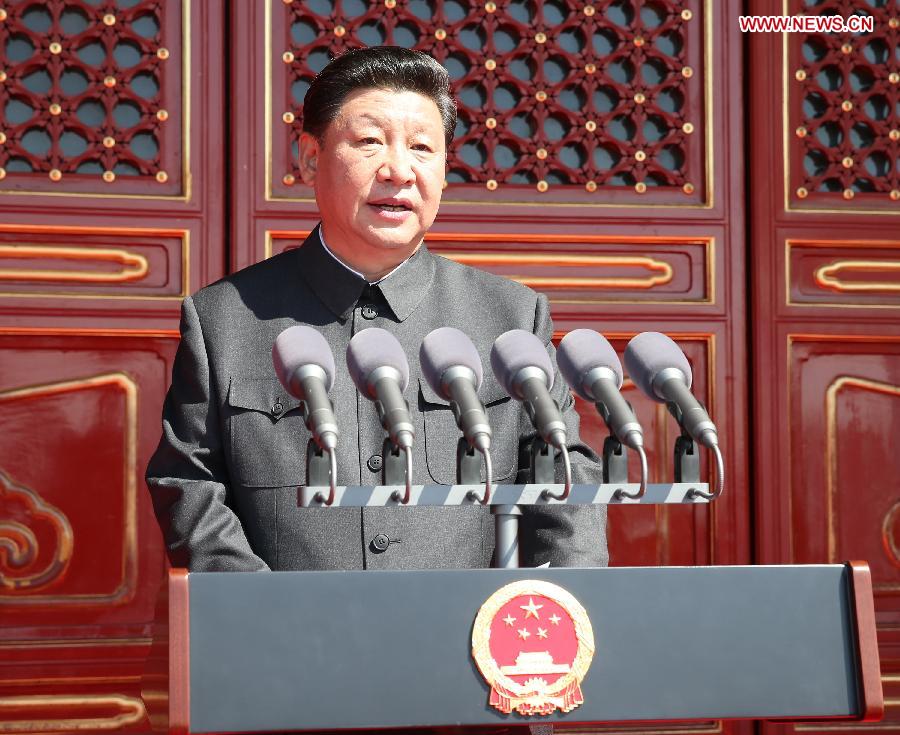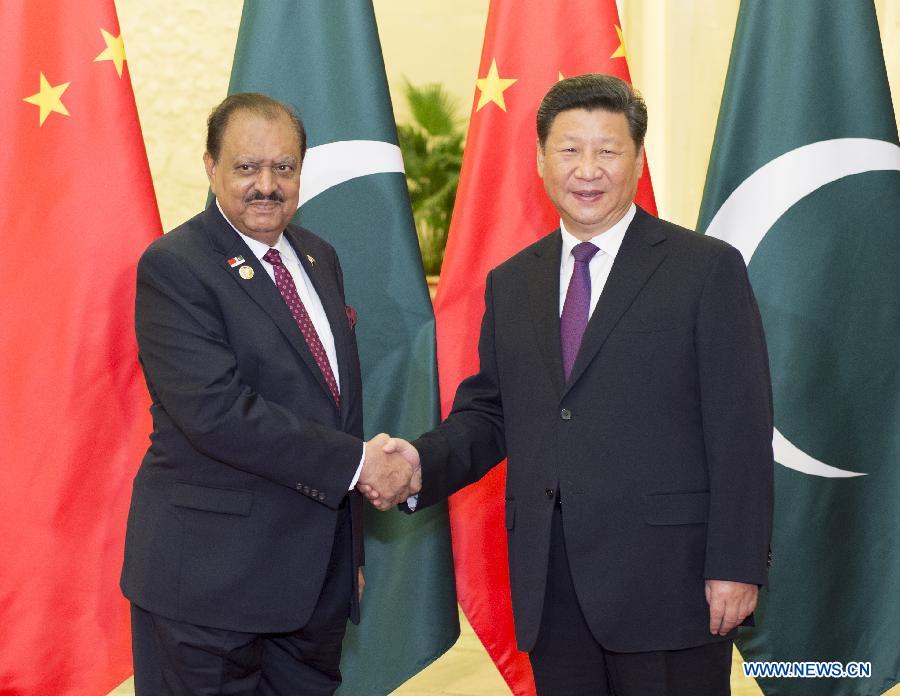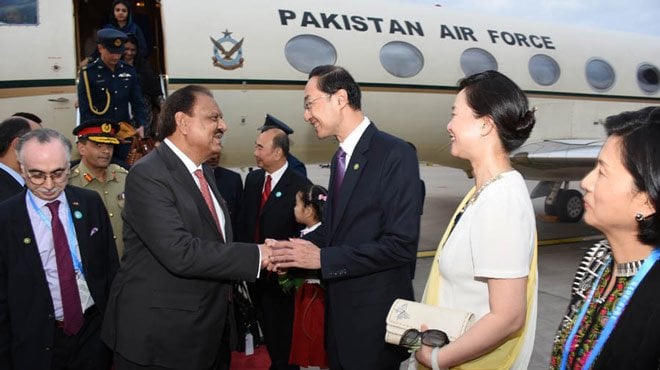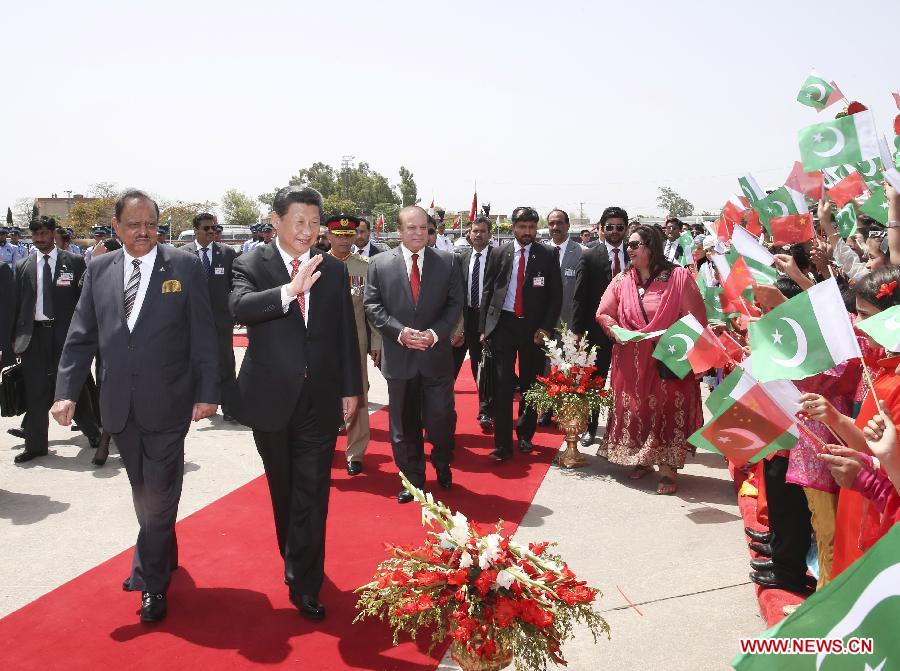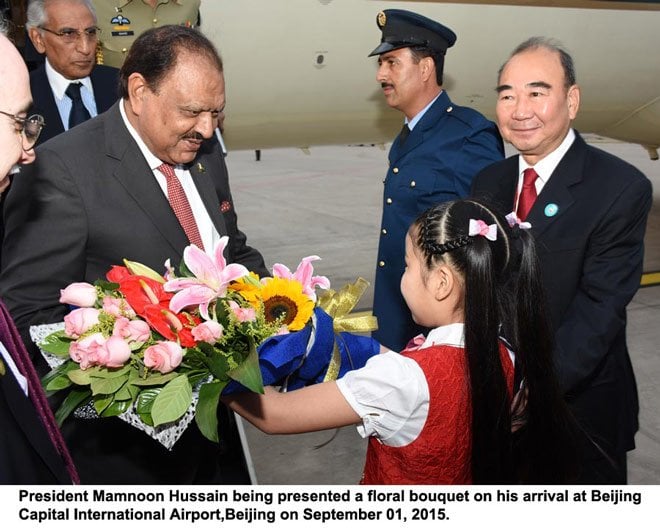Mehmood Ul Hassan Khan
The justice will prevail. The peace will prevail. The people will prevail
Most recently, China held its 15th victory parade since 1949. It was the first non-National day parade held by China at the heart of Beijing, and the first to have invited foreign troops to march in it. It was also China’s first military parade observed by President Xi Jinping as the country’s top leader.
Strategic Importance
Keeping in view the rapidly changing socio-economic realities, geo-political scenarios and the last but not the least, geo-strategic compulsions in and around the region China’s 15th victory parade has multiplier repercussions. It shows its ever-ready military preparedness. It projected its modern weaponry. It showcased its regional allies and international friends to witness its advanced technologies in fields of military production. Through the successful staging of victory parade China warned its enemies and ill-wishers to stay away from it.
The said parade symbolic showed China’s dissatisfaction with the US-dominated post-war order in Asia Pacific, South East Asia and South China Seas. It highlighted President Xi’s China dream/ability the creation a new more collective and inclusive Asian security architecture, offering an alternative to the US-led military alliance system introduced after Japan’s defeat in 1945. The parade served a dual role: a reflection of the past and a signal for the future.
China’s society is a protocol driven society which cares about its past glory and present achievements. The parade embodied President Xi’s goals of national rejuvenation and deliver a potent warning to any adversary. It also conveyed economic message too. At a time of deep economic anxiety for China Xi Jinping’s resolve as the chief of the armed wing of the communist party to protect China’s core interests.
Historic Importance
The 15th victory parade showed China tough struggle against colonial powers and its current concerns over sovereignty and territorial integrity including the East and South China Seas.
The victory of the Chinese People’s War of Resistance against Japanese Aggression is the first complete victory won by China in its resistance against foreign aggression in modern times,” said Xi in his speech prior to the parade.
China’s victory in World War II triggered its onward march of national integration, cohesion, and peace orientation.
“This great triumph opened up bright prospects for the great renewal of the Chinese nation and set our ancient country on a new journey after gaining rebirth,” Xi added.
Historic Perspectives
Japan invaded Northeast China in 1931. Over 35 million soldiers and civilians were killed and injured in China. Japan signed its formal WWII surrender on Sept. 2, 1945, and China celebrated its victory the following day.
Xi Jinping greeted his “comrades” from the People’s Liberation Army (PLA) and the People’s Armed Police who stood to attention down the length of Beijing’s magnificent Chang’an Avenue.
“Follow the Party! Fight to win! Forge exemplary conduct!” over 10,000 servicemen and women saluted Xi and exclaimed.
China’s Aspiration of Peace
On the Tian’anmen Rostrum where late Chinese leader Mao Zedong pronounced the birth of New China 66 years ago, Xi, dressed in a sharply cut, high-collared Mao suit, highlighted China’s aspiration of peace.
The Chinese president was joined by dozens of heads of state and government as well as international organizations including UN Secretary-General Ban Ki-moon, Russian President Vladimir Putin, and Republic of Korea President Park Geun-hye. The United States, Britain and France sent government representatives to attend the parade. Former German chancellor Gerhard Schroeder and former British Prime Minister Tony Blair was also present.
China’s victory parade reflected its strong commitment towards peace and security.
“China will remain committed to peaceful development. We Chinese love peace. No matter how much stronger it may become, China will never seek hegemony or expansion. It will never inflict its past suffering on any other nation,” said Xi.
China’s Valuable Services in Peace-keeping Missions
As a permanent member of the UN Security Council, China takes a serious attitude toward peacekeeping missions, which are conducted under the authorization of the Council. According to the Ministry of National Defense (2015), over 30,000 Chinese peacekeepers have served overseas in different peace keeping missions, with 10 of them losing their lives. Chinese peacekeepers have built or repaired over 11,000 km of road and more than 300 bridges. They have removed 9,400 mines or unexploded devices, and received 149,000 patients.
China endured a turbulent century from 1840 to 1949, making Chinese people value peace and become determined to safeguard it. As China’s national strength has risen over the past 25 years, its peacekeeping presence has grown, with more personnel and diversified tasks. China’s peace mission is very active in South Sudan, Darfur of Sudan, Liberia, West Sahara, Ivory Coast, Congo, Cambodia and South Lebanon.
In recent past, China evacuated foreigners and Pakistanis from the different parts of Yemen and played its leading role in securing the lives of so many people.
Salient Features/Fixtures/Optics of China Victory Parade
Prominence Details
Participation of Heroic and Model Troops They were of special features and in a large variety. Heroic and Model Troops were reviewed in formation for the first time. The formations on foot were the representatives of the standing armies in which the CPC-led Heroic and Model Troops served during the anti-Japanese war. Representatives of the Heroic and Model Troops, comprised of the Eighth Route Army, New Fourth Army, Northeast Anti-Japanese united forces and South China guerrilla column, will be reviewed in formations for the first time.
Formation of Anti-Japanese War Veterans Render Honors by Vehicle Veterans who participated in the anti-Japanese war honored in the frontline and children of heroes and martyrs also participated in the parade, which showed reverence to those who contributed to and sacrificed for the anti-Japanese war.
Generals led Formations Parade troops that carried the history of the anti-Japanese war, formations led by generals were a new feature. During the military parade the formations on foot was led by generals.
Kuomintang Veterans were Reviewed The Kuomintang army played an important role in the anti-Japanese war, and some Kuomintang veterans also participated. The Kuomintang army made its contributions to defending foreign aggression and fighting for national independence, and history has given it a fair and objective assessment.
First Time Participation of Foreign troops First time participation of military representatives and formations from foreign countries made it a remarkable parade.
Showcasing of Latest Weaponry 84 percent of the displayed weaponry was made public first time including the 95-1 automatic rifle, 95B-1 short assault rifle, type-03 automatic rifle added with bayonet, 96A main battle tank (MBT), Tank Biathlon-2014, type-05 amphibious tank, the new-generation 04A IFV, the Red Arrow-10 anti-tank guided-missile launcher system, the new crawler 122mm modular self-propelled rocket launcher system, the type-07 35mm self-propelled anti-aircraft gun, the DF-16 short-range ballistic missile, DF-15 and DF-21D.
Aviation Formation Displayed Dazzling Equipment It included the J-11B fighter, J-10B, J-10A, J-15, the H-6K “Mars” medium-range strategic bomber, Y-20 strategic transport aircraft, the WZ-10 attack helicopter, the WZ-19 attack helicopter nicknamed “Black Whirlwind” and China’s latest heavy-duty transporter, the Z-18A.
Naval Formation Focused on Ship-Borne Weapon It included the Naval Hongqi-9 anti-aircraft missile, the YJ-18 anti-ship missile, the YJ-63 missile and the YJ-12 air-launched anti-ship missile.
Source: Different Chinese Dailies English Newspapers
Different Segments of the Parade
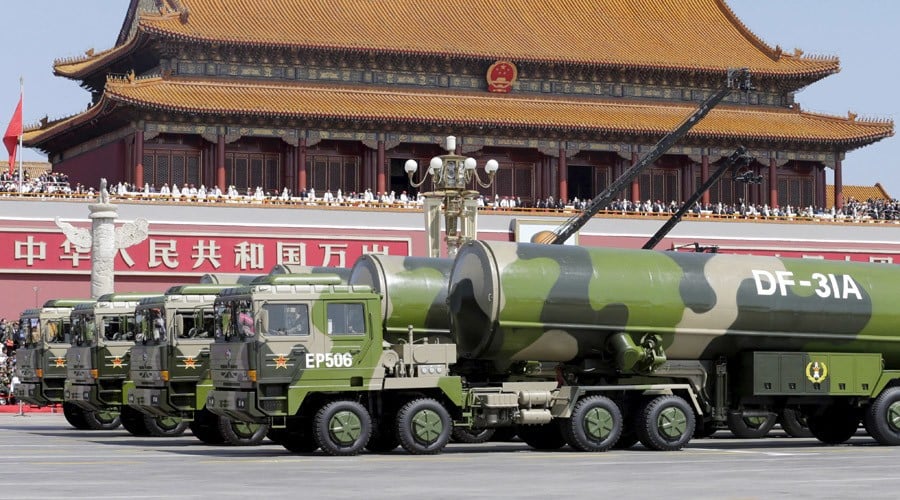
Helicopters carrying China’s national flag and the PLA flag drew the curtains for the much-anticipated military parade. Another 20 choppers flew in a formation that spelt “70” in the air, followed by seven training aircraft trailing colored smoke.
On the ground, WWII veterans, chest bristling with medals, rode in convertibles amidst tides of applause. During the parade excitement and thrill filled Tian’anmen Square as the PLA guards of honor and 10 foot formations each named after a morale-boosting battle fought by Chinese troops who became China war heroes and model combatants marched by in impeccable synchrony and coordination.
Soldiers drilled to perfection for months, past the Tian’anmen Rostrum in 128 carefully measured paces, each precisely 75 cm.
First-ever Participation of Foreign Troops
But the highlight for many of the 40,000 audience present and hundreds of millions more who watched the parade on television or via Internet was the first-ever participation of foreign troops in a Chinese military parade in Beijing.
Nearly 1,000 foreign troops from 17 countries marched at the heels of their PLA counterparts, drawing cheers and applause. It was the first time that foreign troops had been invited to a Chinese military parade at the Tian’anmen Square.
Composition/Formation of Parade
The 70-minute parade included modules for ground combat, air defense and missile defense, maritime attacks, strategic strikes, communication support, and logistics and armament support. It indicated a change of the PLA training strategy, with more focus on actual combat.
Showcasing of home-made conventional and nuclear weaponry
China showcased its home-made conventional and nuclear weaponry, which bespoke the PLA’s long march from an army mainly composed of infantry to informationized military. Eighty-four percent of the 500 pieces of armament rolled out had never been shown to the public before.
Showcase of Military Strength
In previous national day parades China has rolled out new weapons systems, but this event was a different order of magnitude. According to Chinese defence sources, more than 500 items of latest Chinese weaponry was displayed, 84 percent of which was revealed in public for the first time.
The air force showed its latest upgraded long-range bombers, fighter jets, early warning and control (AWACS) aircraft as well as helicopter gunships, while the PLA Navy (PLAN) displayed its latest carrier-capable fighter jets and anti-ship missiles. A special feature of the parade’s air display was an air re-fueling demonstration 500m above Tiananmen Square.
China showcased its latest and most sophisticated weapons systems including drones, air defence, command and control systems and seven types of ballistic missile. The PLA’s Second Artillery Force (SAF), the guardian of China’s nuclear ballistic missile capability was also actively participated.
Moreover, China displayed its Dongfeng-5B intercontinental strategic missiles designed to carry nuclear warheads, and the Dongfeng-21D anti-ship ballistic missiles described by some media as the “carrier killer.” Other cutting edge weaponry included the PLA’s state-of-the-art tanks, unmanned aerial vehicles, and its new generation of airborne early warning and control aircraft, carrier-based fighters and attack helicopters which streaked low across the skies.
It also projected its HJ-10 anti-tank missiles, HQ-12 anti-aircraft missiles and the third-generation carrier-based medium-long range air defense missiles during the 15th victory parade. Its shore-based anti-ship missiles capable of destroying large targets were also made public.
It reflects the latest modernization of the Chinese armed forces, which was a result of the country’s constant economic and technological progress during the past so many years.
Historic Importance
President Xi presented commemorative medals to veterans who fought in the Chinese People’s War of Resistance against Japanese Aggression. This parade was a significant opportunity for the world to better understand the huge contribution Chinese forces made to the ultimate defeat of Japan in 1945.
When war broke out in Europe in 1939, China had already witnessed Japanese aggression on its own soil for eight years and had been invaded two years earlier. According to Chinese media, nearly two million Japanese soldiers killed by the allies during World War II; 70 percent of them were on Chinese soil.
The parade involved PLA units with histories of combat with the Japanese imperial army. The Northeast United Anti-Japanese Force and South China Guerrillas were also participated. Two veteran contingents comprising both communist and Kuomintang (KMT) combatants, many in their nineties also attended the said parade.
The PLA has also paid special attention to the role of women in China’s armed forces. Fifty-one servicewomen marched in the Chinese honour guard, which recruited women for the first time last year. Tian Ou China’s first and only female general to join the parade lead the formation. In addition, an all-female medical team named China’s Eighth Route Army during the war also took part in the parade.
The victory of the Chinese People’s War of Resistance against Japanese Aggression is the first complete victory won by China in its resistance against foreign aggression in modern times. It crushed the plot of the Japanese militarists to colonize and enslave China and put an end to foreign aggressors in modern times. This great triumph re-established China as a major country in the world and won the Chinese people respect of all peace-loving people around the world. This great triumph opened up bright prospects for the great renewal of the Chinese nation and set our ancient country on a new journey after gaining rebirth.
During the war, with huge national sacrifice, the Chinese people held ground in the main theater in the East of the World Anti-Fascist War, thus making major contribution to its victory. In their war against Japanese aggression, the Chinese people received extensive support from the international community. The Chinese people will always remember what the people of other countries did for the victory of their War of Resistance.
Pakistan’s President Visit to China
Most recently, President Mamnoon Hussain visited China. He also attended a grand event to commemorate China‘s 70th anniversary of victory against Japanese aggression in World War II. His latest official visit to china “Iron Brother” truly reflected the deep-rooted relations between the two countries.
Participation of Dignified Personalities & Officials
The president along with 30 heads of state attended the military parade of China‘s People’s Liberation Army held at historic Tiananmen’s Square. A 75-member contingent of Pakistan’s armed forces, on the invitation of China, also marched along the Chinese army and other troops from foreign countries.
Pakistan’s President different Meaningful Meetings
The president held meeting with Chinese President Xi Jinping and discussed issues of mutual interest. He also attended a dinner hosted by President Xi, which was joined by other heads of state and governments. The president addressed a lunch hosted by Chinese People’s Association for Friendship with Foreign Countries (CPAFFC). He also met with executive vice premier and member of Standing Committee of Political Bureau of Communist Party. President Mamnoon interacted with the Chinese media and gave interviews focusing importance of Sino-Pak bilateral relations.
Pak-China Friendship Eternal and Irreplaceable
President Mamnoon said Pakistan and China would remain eternal and irreplaceable friends as their friendship was playing a pivotal role in pursuing the common objectives of peace and development in the region. Addressing a luncheon jointly hosted by the China International Culture Communication Centre and China-Pakistan Friendship Association, he said Pakistan was committed to ensuring continuity in Pakistan-China friendship from generation to generation.
President’s Visit and Development of China-Pakistan Economic Corridor (CPEC)
The president’s visit proved helpful in fast-tracking the development on China-Pakistan Economic Corridor (CPEC). CPEC is a game changer initiative for the further strengthening of socio-economic prosperity, commercial diplomacy, energy supply, job creation and above all regional connectivity. It has multiplier effects not only Pakistan but also for the entire region. It would promote immense business activity. It would further enhance the inflows of foreign direct investments (FDIs). It would also gear-up the chances of joint venture along with the development of free economic zones in the country. It would revolutionize regional transportation systems.
According to an official figure, Pakistan will get around 5,600MW of electricity through five major projects under the China Pakistan Economic Corridor (CPEC) by the year 2017-18. Many private Chinese companies are already working on these energy projects with the government of Pakistan and its provincial capitals. The total cost of these projects has been estimated around US dollar 10 billion, being provided by the Chinese Banks. Some of the cost will be borne by the companies themselves which enjoy the complete support of the Chinese top leadership.
These energy projects will be functional as Independent Power Plants (IPPs) under the power purchase agreement and there will be no liabilities on the government of Pakistan as far as their construction is concerned. The government of Pakistan will purchase the electricity as per relevant IPPs rules and regulations.
Name of the Energy Projects Capacity Location
Port Qasim 1320mw Karachi/Sindh
Hubco 1320mw Balochistan
Thar coal-based power plants (2) 640 mw Sindh
Quaid-i-Azam solar Park project 1000mw Bhawalpur
Coal-fired project 1320mw Sahiwal
Suki Kinari hydel 800mw Khyber PakhtunKhwa
Source: Different Dailies Newspapers
Infrastructure Development Projects
It is hope that work on KKH-phase-II, Karachi-Lahore motorway (Multan-Sukkar section), Gowdar international airport and Gwadar East Bay Expressway will be started before the end of the year and completion is expected by the end of 2017.
Chinese Loans
Under CPEC the Chinese government is providing mixed loans facility including grant assistance, interest-free and concessional loans to undertake these projects. Another important area of bilateral cooperation under the CPEC is the development of special industrial zones. A pilot project at Gwadar is being started. The project will include a commercial complex (hotel, exhibition hall, apartments, and shopping mall), fish and marble processing factories and a captive power plant.
Pak-China: Strategic Cooperative Partnership
President Mamnoon’s visit to China reviewed important aspects of bilateral relations. Exchanges were also taken place on regional issues and international developments. Pakistan and China attach highest priority to their strategic cooperative partnership and mentioned that exchanges at the highest level are the hallmark of their unique friendship and wide-ranging cooperation. The president’s has further consolidated the existing “all-weather” relations between Pakistan and China in all areas of importance, especially political, economic and strategic.
Pakistan’s Commitment against East Turkestan Islamic Movement (ETIM)
President Mamnoon Hussain said almost all members of the Uighur militant group, the East Turkestan Islamic Movement (ETIM), have been eliminated from Pakistan. Meeting with Chinese President Xi Jinping in the Great Hall of the People, President Mamnoon said the massive military operation, codenamed Zarb-e-Azb, in North Waziristan Agency “has been successful in eradicating terrorism from our country”.
Pakistan’s Peaceful Relations with Neighbours
President Mamnoon reiterated Pakistan’s desire to have peaceful relations with its neighbours, including India, and told the Chinese leaders that Pakistan has always been willing to hold dialogue with India for resolution of all outstanding issues. President Mamnoon also said that Pakistan valued China’s efforts in promoting intra-Afghan dialogue for sustainable peace in Afghanistan.
Chinese People’s Sufferings and Sacrifices
He said Pakistan recognised the sufferings and sacrifices of the Chinese people in the Anti-Fascist War. He further said that the Sino-Pak friendship enjoyed across-the-board political, institutional and popular support in both countries.
Satisfaction on CPEC
President Mamnoon expressed satisfaction over the progress of China-Pakistan Economic Corridor (CPEC) and added that the project would usher in peace and prosperity not only for Pakistan, but also for the entire region. He said Pakistan had taken special measures to provide security to Chinese personnel working on the CPEC project.
Chinese President Xi Jinping
President Xi said his country attaches high priority to its strategic partnership with Pakistan and will always support it on all international and regional issues. “China values its friendship with Pakistan and considers it a high priority in its foreign policy,” he added.
“China will unswervingly support Pakistan’s efforts in safeguarding its national security,” Chinese President Xi. President Xi assured his Pakistani counterpart that he had the firm resolve that the Chinese government and companies would keep their maximum focus on the ongoing projects in Pakistan and would ensure their timely completion.
President’s Meeting with China’s Executive vice Premier and Member of Standing Committee of political Bureau of Communist Party
During his meeting with China’s Executive vice Premier and Member of Standing Committee of political Bureau of Communist Party, Zhang Gaoli the President Mamnoon said Pakistan and China had achieved a consensus on various infrastructure and energy projects and were determined for their effective implementation and timely completion. The President said forging greater regional connectivity through infrastructure development, energy and transnational trade was the key to prosperity and would bring economic progress in not just Pakistan and China but the entire region.
Importance of “One Belt”, One Road, “Silk Road Economic Belt” and “Maritime Silk Route
President Mamnoon appreciated President Xi vision of “One Belt, One Road” that also includes the “Silk Road Economic Belt” and “Maritime Silk Route” and welcomed the establishment of the Silk Road Fund. He also congratulated China for establishing the Asian infrastructure Investment Bank (AIIB).
Concluding Remarks
China 15th victory parade was full of energy, emotion and colors. It reflected its success in the past against the so many colonial powers. It highlighted its immense human struggle for a national cause and preserving of sovereignty.
It projected its current concerns and remedies in the fields of science and technology, cyber warfare, modern weaponry, human resources management and above all power politics in the Asia Pacific, South East Asia and South China Seas. It showcased its military preparedness and operational strength in the times of war and peace.
The Chinese victory parade also showed its leadership strong commitments towards greater peace and harmony in the region as well as world. A larger number participation of the foreign militaries formation and armed forces clearly showed China’s strategic gains in the region and around the globe.
Recently held China’s victory parade had also a human face. It reconfirmed China’s government and its people respect towards their real heroes in the World War II. Their struggle and sacrifices will never be forgotten.
President of Pakistan being a strategic ally of China also attended the said parade and used this visit for the further strengthening of Pak-China strategic friendship, Pak-China Economic Corridor, Silk Road and the last but not the least, Asia Infrastructure Bank.
Pakistan attaches great importance to its relations with China and considers every issue and problem of China as its own. China should share its socio-economic experience and knowledge with Pakistan in order to make it’s an enterprising country in the days to come.
China is very active in restoring the peace in Afghanistan because it has great stakes in it. Pakistan and China jointly work for the peace and stability of Afghanistan because it would open greater opportunity of energy and economic cooperation with the CIS and beyond. Pakistani armed forces and paramilitary forces should have joint mechanism to foster the war against terrorism
Pak-China Economic Corridor is the project of the century for Pakistan. It would provide eliminate Pakistan’s looming energy worries, create jobs, attract public-private foreign direct investments from China, brighten the scope of joint ventures and establishment of more and more free economic zone in the days to come.
Pakistan-China Economic Corridor project now must be geared-up because it provides a comprehensive package of cooperative initiatives and projects, which covers the key areas including regional connectivity, information network infrastructure, energy cooperation, industries and industrial parks, agricultural development and poverty alleviation, tourism, financial cooperation as well as livelihood improvement including municipal infrastructure, education, public health and people-to-people communication. It should be promoted in priority and step by step incorporating the long term, short and medium term needs, based on the concrete conditions of Pakistan. In order to achieve more balance in the current mutual trade both countries must push forward the implementation of the early harvest projects as well as the preparation of the projects of the long term plan in all sectors.
In order to further integration and development of economy and its different sectors Pakistan China should assist Pakistan being the a member of Asian Infrastructure Investment Bank ($50bn) which is designed to provide infrastructure funds to the Asia-Pacific region.
China will provide different facilities to government and private companies in the country which must be revised and rationalized. Pakistan’s future socio-economic prosperity is directly linked with the complete elimination of terror and successful implementation of Pak-China Economic Corridor. Thanks God, civil leadership and military brasses are on the same page. The Chief of Army, General Raheel Sharif once again assured his full commitment towards the Pak-China Economic Corridor.
China has managed to achieve the status of a global economy. China is securing its socio-economic, geo-political and geo-strategic interests through greater regional commercial diplomacy because it does not believe in use of naked power. China’s maritime Silk route strategy under the ‘One Belt One Road’ initiative, China has been building ports in South Asia. China has completed the Gwadar Port (extension progress is still in progress), Chittagong Port, Hambantota Port, four ports in Myanmar, and is now building a port in the Indian State of Gujarat. The building of these ports is not for strategic and naval reasons. They are purely for commercial reasons.
US has been active to implement its highly projected China’s encircling policy via Mongolia, South Korea, Vietnam, and Japan. Asia witnessed so many great games since ancient and colonial times. It is time to reconnect Asia, overcome its poverty, and build new roads of confidence and trust. China is doing great job in reconnecting people and countries through commercial diplomacy because economic prosperity would be ultimate victor.
We are living in a complex world of power politics. It is the bitter lesson of the modern human civilization that peace is guaranteed through “War Theater” because weakness is a curse which always ready to crush territorial sovereignty, national pride and invokes unduly compromises. Showcasing of martial muscles is also must to keep the enemies, and ill-wishers at bay. Long live Chinese army and its wise leadership.
